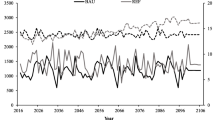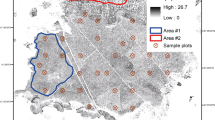Abstract
The aim of this research was to identify species suitable for plantation. We first identified species for potentially suitable for plantation based on ecological capabilities regarding soil properties. We determined the area of plantation for different species based on ecological capabilities. Then, we collected relevant data such as growth patterns of different species, labor requirements for plantation and plantation cost. A linear programming model and two integer linear programming models were used for optimization. The appropriate species based on ecological capabilities were ash, elm, maple, oak and bald cypress. A linear programming model was used based on ecological capabilities classification to determine the land area of different species for plantation. Then, two integer linear programming models were employed to select the species for plantation. We set ecological properties unequal for all of the species in the first run of the integer programming model. Two groups were classified: group one included maple and ash; group two included bald cypress, oak and elm. The second integer programming model assumed equal ecological properties for all the species. Results of linear programming showed that maple and bald cypress were appropriate for plantation at the site and their plantation areas should be 151.3 and 355.3 ha, respectively. Results of the first integer linear programming model showed that maple and bald cypress would be economically profitable for plantation. The results of the second integer linear programming model showed that only bald cypress would be appropriate for plantation.

Similar content being viewed by others
References
Central Bank of the Islamic Republic of Iran (2013) Consumer price index report. www.cbi.ir
Cruz-Bello GM, Sotelo-Ruiz ED (2013) Coupling spatial multiattribute analysis and optimization to identify reforestation priority areas: a case Study in Central Mexico. Mt Res Dev 33(1):29–39
Duangsathaporn K, Prasomsin P (2005) Application of linear programming in forestry: management planning for a forest plantation. In: Operation Research Conference, Graduate School of Applied Statistics, Bangkok, Thailand, September 2005
FAO (2013) Global data on forest plantations resources. http://www.fao.org/docrep/004/Y2316E/y2316e0b.htm
Global outlook for plantations (1999) ABARE research report (Australia), no. 99.9/Australian Bureau of Agricultural and Resource Economics, Canberra, p 99
Hof JG, Baltic TJ (1990) Cost effectiveness from regional optimization in the USDA Forest service. J For Sci 36(16):939–954
Hoganson HM, McDill ME (1993) More on forest regulation: an LP perspective. Soc Am For 39(27):321–347
Kanninen M (2010) Plantation forests global perspective. In: Bauhus J, van der meer PJ, kanninen M (Eds). Ecosystem goods and services from plantation forests, pp. 1–15
Khanjani Shiraz B, Adeli A, GorjiBahri Y (2005) The investigation and comparative of growth and wood production of Alnus glutinosa, west of Guilan province (North of Iran). Pajouhesh-va-Sazandegi J 69:14–25 (In Persian)
Kiyan G, Jalilvand H (2011) Measurement of diameter increment and standing volume of maple (Acer velutinum) plantations (case study: Talu Kola and Emre 2district, compartment No. 1). For Rang Mag 90–91:22–28 (In Persian)
Kowero GS, Dykstra DP (1988) Improving long-term management plans for a forest plantation in Tanzania, using LP. For Ecol Manag 24:203–217
Manley BR, Threadgill JA (2013) LP Used for valuation and planning of New Zealand plantation forests. Oper Res Manag Sci 21(6):66–79
Mat Isa AZ (1990) The application of LP for forest land use and timber management planning with watershed considerations in Terengganu, Peninsular Malaysia. Oregon State University, Corvallis, p 107
Mgeni ASM, Price C (1993) Planning of forest plantation investments with the aid of LP: a case study of Sao Hill Forest, Tanzania. For Ecol Manag 62:51–72
Misir M, Karahalil U (2005) Overcoming spatial constraints in forest management using integer programming: a case study. In: The 7th Balkan Conference on operational research. BACOR 05. Constanta, May 2005, Romania
Mohammadi Limaei S (2006) Economically optimal values and decisions in Iranian forest management. Swedish university of agricultural sciences (SLU), Umea, p 110
Mostafanejad SR, Sadati SE (2008) Results of adaptation trial with three Taxodiaceae species at Chamestanplain Mazandaran province. For Pop Res 16(2):230–240
Ostadhashemi R, RostamiShahraji T, Roehle H, Mohammadi Limaei S (2013) Carbon production potential of different tree species plantations in north of Iran. Ann Biol Res 4(12):106–114
Phillips VD, Tvedten AE, Liu W, Merriam RA (1997) Integrated forest products from former sugarcane plantations in Hawaii. For Ecol Manag 92:29–38
Plan Shafaroud Forest Management (2008) Forest plantation schedule in Gisom-Pilambara area, Iranian Forests. Rangelands and watershed management organization, Tehran, p 298
Rouchiche S, Haji Mirsadeghi MA (2003) Role of planted forests and trees outside forests in sustainable forest management: Islamic Republic of Iran—Country case study. Working paper FP/32E, FAO, Rome, Oct 2003
Rowse J, Calum JC (1998) Forest harvesting to optimize timber production and water runoff. Soc-Econ Plan Sci 32(4):277–293
Tan LP, CO Fong (1988) Determination of the crop mix of a rubber and oil plam plantation-a programming approach. Eur J Oper Res 34:362–371
Troncoso J, D’Amours S, Flisberg P, Roennqvist M, Weintraub A (2011) A mixed integer programming model to evaluate integrating strategies in the forest value chain—a case study in the Chilean forest industry, University of Montreal, Canada, working paper, CIRRELT-2011-28, p 29
Vanlisuta C, Prombanpong S (2012) An integer programming approach to optimize the plantation in order to reduce global warming. Adv Mater Res 548:767–771
Wang YY, Bai GX, Shao GF, Cao Y (2014) An analysis of potential investment returns and their determinants of poplar plantations in state-owned forest enterprises of China. New For 45:251–264
Yousefi M, Pourmajidian MR, Karimi M, Darvishi L (2013) Quantitative and qualitative evaluation of forest plantations by four species and suggestion the appropriate species in the Hyrcanian forest. Eur J Exp Biol 3(5):352–360
Author information
Authors and Affiliations
Corresponding author
Additional information
The online version is available at http://www.springerlink.com.
Corresponding editor: Hu Yanbo.
Rights and permissions
About this article
Cite this article
Mohammadi, Z., Limaei, S.M. & Shahraji, T.R. Linear programming approach for optimal forest plantation. J. For. Res. 28, 299–307 (2017). https://doi.org/10.1007/s11676-016-0318-y
Received:
Accepted:
Published:
Issue Date:
DOI: https://doi.org/10.1007/s11676-016-0318-y




